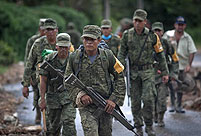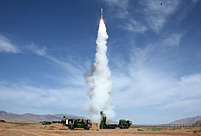Iran has started to mass-produce a home-made unmanned aerial vehicle (UAV) and unveiled domestically manufactured air-launched missiles during "Sacred Defense Week" which began on Sunday, marking the 33rd anniversary of the Iran- Iraq war.
Iran announced on Friday the mass-production of the UAV Shahed 129, a combat drone capable of carrying eight bombs or domestically- manufactured Sadid missiles simultaneously, which is designed to hit stationary and mobile targets alike, said Press TV.
Shahed (Witness) 129 has an effective operational radius of 1, 700 km (1,056.33 miles) in terms of accurate targeting, flight endurance of 24 hours on a single fuel run and a flight ceiling of 24,000 feet. It has a monitoring capability of 200 km (124.27 miles) radius.
Commander of the Islamic Revolution Guards Corps (IRGC) Major General Mohammad-Ali Jafari on Friday described Shahed 129 as the IRGC's latest achievement in the area of UAV production, saying that "This smart and precise ... technology can facilitate the work of thousands of soldiers, (police) stations and different border guard stations which face numerous hardships and vulnerabilities, and it can also take charge of the security of ( country's) borders," semi-official Fars news agency reported.
Shahed 129 has been designed and produced in IRGC's Aerospace Division and is a state-of-the-art drone, he said, contending that the United States is the only other country which is building such a hi-tech drone.
Besides, Brigadier General Amir-Ali Hajizadeh, commander of the IRGC's Aerospace Division, said Friday that the drone can help ensure sustainable security for the country, according to Press TV.
"Shahed 129 can easily track and identify bandits, terrorists and drug smugglers as well as anyone targeting the Islamic Republic of Iran's sustainable security and can fire missiles at them upon orders from commanders," said Hajizadeh.
In March 2012, Iranian experts managed to produce Shaparak ( Butterfly) drone with a maximum operational radius of 50 km (31 miles), and a maximum flight ceiling of 15,000 feet, according to Fars.
In February 2011, Iran inaugurated the production line of two home-made UAVs with bombing and reconnaissance capabilities.
The two hi-tech drones named Ra'd (Thunder) and Nazir ( Harbinger) are capable of conducting long-range reconnaissance, patrolling, assault and bombing missions with high precision.
In 2010, Iran unveiled the country's first home-made combat UAV, named Karrar, which is capable of carrying a military payload to carry out bombing missions against ground targets. It is also capable of flying long distances at a very high speed.
Iran also unveiled two domestically manufactured air-launched missiles on Wednesday.
"By designing and building these missiles for the first time in the country, not only will the fighter jets of our country's Air Force be equipped with advanced air-launched Qader (Mighty) missiles with a range of over 200 km (124.27 miles) and air- launched Nasr (Victory) missiles with a range of over 35 km (21.74 miles) , but their operational and deterrence power will also increase considerably," said Defense Minister Hossein Dehqan.
The missiles enjoy high-precision capability, especially in targeting vessels, high destruction power as well as high resistance against radio jamming, and they can be fired quickly by fighter jets even at low altitudes, he was quoted as saying by Press TV.
Also, Commander of the Iranian Army's Ground Forces Brigadier General Ahmad-Reza Pourdastan said Wednesday that Iran's Army will unveil a domestically made unmanned aerial vehicle (UAV) on Sept. 28.
The remote-controlled aircraft Yasir, which has high flight capabilities and has been jointly designed and mass-produced by experts at the Defense Ministry and the Army's Ground Forces, will be unveiled in an official ceremony, said Pourdastan.
Iranian Army's Ground Forces commander announced earlier that Iran's Army would stage major drills in November, in which domestically designed and manufactured advanced weapons would be tested during the week-long drill.
The military exercise, code-named Qamar-e Bani Hashem, would be conducted in an area covering 250,000 square kilometers, said Pourdastan without specifying the area where the drills will be held.
"The capabilities of armored and airborne units will be tested in the drill," he was quoted as saying.
Also, Commander of Khatam al-Anbiya Air Defense Base Brigadier General Farzad Esmaili said that the Iranian Armed Forces, including Army units, the IRGC and Basij forces, will stage a large-scale joint air defense drills in a mountainous region of the country in late October.
Nearly 8,000 military personnel will be directly involved in the drill, while another 17,000 will provide logistics for the maneuver, said Esmaili without further elaboration.
 Storms leave 97 dead, 58 missing in Mexico
Storms leave 97 dead, 58 missing in Mexico New model of indigenous surface-to-air missiles testfired
New model of indigenous surface-to-air missiles testfired  118.28-carat diamond to be auctioned in HK
118.28-carat diamond to be auctioned in HK Maternal love under streetlight
Maternal love under streetlight Naked foreign student sits in the middle of a road in Haikou
Naked foreign student sits in the middle of a road in Haikou  Colorful Yunnan: Enjoy the natural beauty
Colorful Yunnan: Enjoy the natural beauty Harbin named Chinese city with most beautiful women
Harbin named Chinese city with most beautiful women New college students' military training in Guangzhou
New college students' military training in Guangzhou Rugby girls
Rugby girls PLA's 38th Group Army conduct training
PLA's 38th Group Army conduct training Residences of the royal house of Savoy
Residences of the royal house of Savoy The last days of Wan Aihua
The last days of Wan Aihua Highlights at 12th National Games of China
Highlights at 12th National Games of China Beijing Film Academy welcomes freshmen
Beijing Film Academy welcomes freshmen Large mahjong party sets new world record
Large mahjong party sets new world recordDay|Week|Month